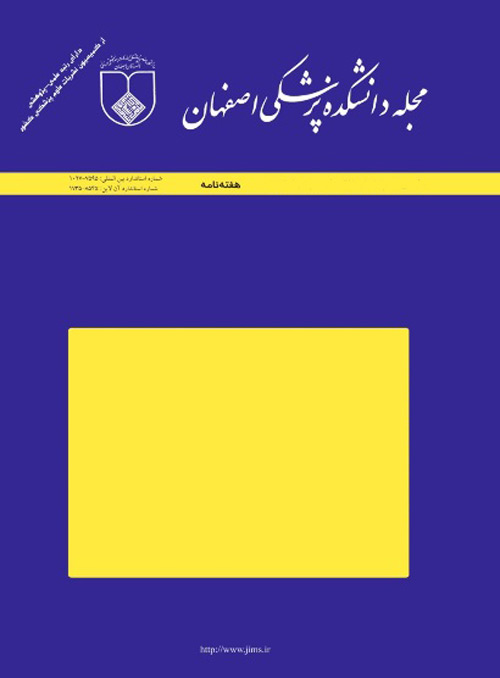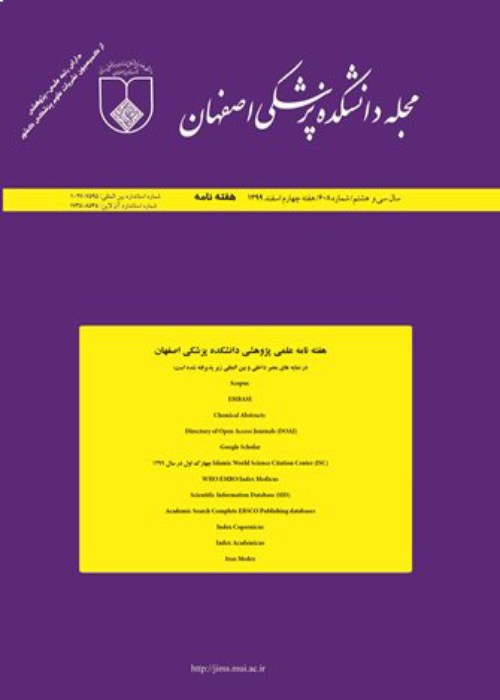فهرست مطالب

مجله دانشکده پزشکی اصفهان
پیاپی 551 (هفته سوم دی 1398)
- تاریخ انتشار: 1398/10/18
- تعداد عناوین: 3
-
-
صفحات 1240-1244مقدمه
استئوآرتریت مفصل زانو، شایع ترین بیماری مفصلی است که شیوع آن در افراد بالای 65 سال بیشتر می باشد. هدف از انجام این مطالعه، بررسی تاثیر بلوک کانال اداکتور بر متغیرهای همودینامیک و بی دردی پس از عمل جراحی تعویض مفصل زانو و کمک به یافتن راه حلی مناسب برای کنترل درد در این افراد بود.
روش هادر این مطالعه ی کارآزمایی بالینی، 68 بیمار کاندیدای عمل جراحی تعویض مفصل زانو در دو گروه 34 نفره ی مورد و شاهد توزیع شدند. در گروه مورد، بیماران کاندیدای عمل جراحی تعویض مفصل زانو به وسیله ی تجویز مارکائین (15-5/12 میلی گرم) بی حسی نخاعی دریافت کردند و سپس، به روش اولتراسونوگرافی، از قسمت قدامی ران بلوک کانال اداکتور با تجویز 15 میلی لیتر مارکائین 5/0 درصد همراه با 5 میکروگرم/میلی لیتر اپی نفرین انجام شد. در گروه شاهد، بلوک با همان تکنیک مشابه گروه اول انجام شد، اما به جای دارو، از نرمال سالین استفاده گردید. متغیرهای همودینامیک، درد بعد از عمل و رضایتمندی بیمار و جراح در دو گروه بررسی و مقایسه شد.
یافته هاشدت درد بعد از عمل در گروه مورد در زمان های 6 و 12 ساعت بعد از عمل به صورت معنی داری کمتر از گروه شاهد بود. همچنین، میزان نیاز به مسکن در گروه مورد در 24 ساعت بعد از عمل به صورت معنی داری کمتر از گروه شاهد بود (050/0 > P).
نتیجه گیریاستفاده از بلوک کانال اداکتور، می تواند روش موثری برای کوتاه مدت جهت کاهش درد و نیاز به داروی مسکن بعد از عمل جراحی تعویض مفصل زانو باشد.
کلیدواژگان: کانال اداکتور، درد بعد از عمل، بی حسی نخاعی، همودینامیک، آرتروپلاستی -
صفحات 1245-1251مقدمه
سرطان کلورکتال، از شایع ترین سرطان های گوارشی است. هدف از انجام این مطالعه، بررسی ارتباط برخی عوامل خطر کمتر مطالعه شده در ارتباط با سبک زندگی، کیفیت خواب و فعالیت فیزیکی با سرطان کلورکتال بود.
روش هامطالعه ی حاضر، یک مطالعه ی مقطعی بود که در بیمارستان الزهرای (س) اصفهان در سال 1397 انجام شد. تعداد 50 نفر از بیماران بستری با تشخیص قطعی و اخیر سرطان کلورکتال و تعداد 42 نفر از بستگان درجه ی یک بیماران گروه بیمار به عنوان گروه سالم اول و تعداد 58 نفر از سایر بیمارانی که هم زمان با تشخیصی غیر از سرطان بستری شده بودند، به عنوان گروه سالم دوم انتخاب شدند. خصوصیات دموگرافیک، مصرف دخانیات، الکل، فست فود و نوشیدنی های گازدار، سطح فعالیت فیزیکی با فرم کوتاه پرسش نامه ی International physical activity questionnaire (IPAQ) و کیفیت خواب با پرسش نامه ی Pittsburgh، برای هر فرد تکمیل شد. با آزمون 2χ و One-way-ANOVA، واکاوی متغیرها بین سه گروه انجام گرفت و سپس، متغیرهای با 250/0 > P، وارد مدل Logistic regression شدند و نسبت شانس برای هر یک از عوامل خطر محاسبه شد.
یافته هاسن، سطح تحصیلات و شاخص توده ی بدنی بالاتر و عدم ابتلا به دیابت و سابقه ی کوله سیستکتومی در گروه بیمار بالاتر از هر دو گروه سالم بود، اما این اختلاف از نظر آماری معنی دار نبود (050/0 < P). ابتلا به سرطان کلورکتال در گروه بیمار نسبت به گروه سالم اول (با نسبت شانس معادل 86/2) و همچنین، گروه بیمار نسبت به گروه سالم دوم (با نسبت شانس معادل 57/3) در مردان نسبت به زنان به طور معنی داری بالاتر بود (050/0 > P).
نتیجه گیریشانس ابتلا به سرطان کلورکتال در مردان بالاتر از زنان می باشد.
کلیدواژگان: سرطان کلورکتال، سبک زندگی، کیفیت خواب -
صفحات 1252-1262مقدمه
ارزیابی کیفیت مراقبت نوزاد، برای دست یابی به پیامدهای مطلوب و موثر بر سلامت آینده ی نوزاد ضروری است. هدف از انجام مطالعه ی حاضر، مرور نظام مند معیارهای مورد استفاده در ارزیابی کیفیت مراقبت های نوزاد سالم در مطالعات مختلف، بر طبق الگوی Donabedeian بود.
روش هابانک های اطلاعاتی PubMed، Google scholar، Scopus، Science Direct، Iran medex، Magiran و Scientific Information Database (SID) برای مطالعات مرتبط با کلید واژه های «Healthy newborn»، «Quality of care» و «Quality assessment» و معادل آن ها در Mesh و مترادف های فارسی جستجو شدند. کلیه ی مقالات کمی، کیفی، انگلیسی و فارسی زبان در محدوده ی زمانی ابتدای 1998 تا انتهای سپتامبر 2019، که به بررسی کیفیت در مراقبت های نوزاد سالم پرداخته بودند، وارد مطالعه شدند. از تعداد 2219 مقاله ی دست یابی شده، در نهایت 25 مقاله وارد مطالعه شدند.
یافته هاپس از بررسی مطالعات، معیارهای ارزیابی کیفیت مراقبت نوزاد سالم طبق الگوی Donabedeian در سه گروه جای گرفتند: ساختار (زیرساخت های فیزیکی، تجهیزات و داروها، منابع انسانی با صلاحیت، سیاست ها و دستورالعمل های بالینی)، فرایندها (مراقبت فوری نوزاد و اقدامات دو ساعت اول تولد، مراقبت های غیر فوری و احیای نوزادی)، پیامدها (رضایتمندی مادران، شاخص های مرگ و میر و عوارض نوزادی) بودند.
نتیجه گیرینتایج این مرورنظام مند نشان داد که در حال حاضر، روش ارزیابی کیفیت جامعی برای مراقبت های نوزاد سالم تعریف نشده است و تدوین ابزار جامع و معتبر برای ارزیابی کیفیت این مراقبت ها، به گونه ای که همه ی معیارهای استخراج شده از این مطالعه را در بر بگیرد، به عنوان یک نیاز نظام سلامت برای ارتقای کیفیت مراقبت های نوزادان سالم ضروری است.
کلیدواژگان: مراقبت نوزاد، کیفیت مراقبت، مدل Donabedeian
-
Pages 1240-1244Background
Knee joint osteoarthritis is the most common articular disease among the elderly of more than 60 years. This study aimed to evaluate the effect of adductor canal block on hemodynamic variables and pain after total knee arthroplasty to find a suitable solution for pain control in these patients.
MethodsIn this clinical trial study, 68 patients under total knee arthroplasty were randomly divided into two equal groups. In the first group, the patients received Marcaine (12.5-15 mg) for spinal anesthesia; then, anterior hip ultrasound of adductor canal block was done by injecting 15 ml Marcaine 0.5% along with 5 mg/ml epinephrine. This was repeated in the control group with the similar technique and normal saline was used instead of drug. Hemodynamic variables, postoperative pain, and patient and surgeon satisfaction were all studied in both groups.
FindingsIntensity of postoperative pain in the intervention group was lower than placebo group after 6 and 12 hours of surgery. The need to narcotics in the intervention group was significantly lower than placebo 24 hours after surgery (P < 0.050 for all).
ConclusionUsing adductor canal block is an effective short-term method to reduce the pain and need to narcotics after total knee arthroplasty.
Keywords: Adductor, Postoperative pain, Spinal anesthesia, Hemodynamic, Arthroplasty -
Pages 1245-1251Background
Colorectal cancer (CRC) is one of the most common cancers of gastrointestinal system. The purpose of this study was to determine the relationship between some of less-studied life style risk factors, sleep quality and the level of physical activity, with colorectal cancer.
MethodsThis cross-sectional study was conducted in Alzahra hospital, Isfahan, Iran. 50 newly diagnosed patients with colorectal cancer were entered from admitted patients considering as the patient group, 42 firstdegree relatives of them as 1st healthy group, and 58 admitted patients without any cancer diagnosis (randomly selected) as the 2nd healthy group. Demographic characteristics, smoking, alcoholic beverages and carbonated drinks intake, fast food consumption, physical activity level [based on International Physical Activity Questionnaire (IPAQ) short form] and sleep quality (based on Pittsburg Sleep Quality Questionnaire) were collect by the researcher. Variables were analyzed using chi-square and one-way ANOVA tests, then variables with P-value of less than 0.250 were analyzed through multivariate logistic regression model, and the odds ratio (OR) of each factor was calculated.
FindingsAge, level of education, and body mass index (BMI), as well as no history of diabetes mellitus and positive history of cholecystectomy were higher in the patient group than in the two healthy groups; but the differences were not statistically significant (P > 0.050). Male gender was significantly associated with OR of colorectal cancer in patient group compared with both healthy groups (OR = 2.86 and OR = 3.57 with 1st and 2nd healthy groups, respectively).
ConclusionThe risk of colorectal cancer is higher in men than in women.
Keywords: Colorectal cancer, Sleep quality, Life-style -
Pages 1252-1262Background
Quality assessment of newborn care is essential to achie desirable and affecting future health outcomes. This study aimed to review the criteria used to evaluate the quality of healthy newborn care in different studies systematically based on the Donabedeian model.
MethodsPubMed, Google Scholar, Scopus, Science Direct, Iranmedex, Magiran, and Scientific Information Database (SID) databases were searched oncerning relevant studies with the keyword of "healthy newborn" and "quality of care" and "quality assessment" and their equivalent in Mesh and Persian synonyms. All quantitative, qualitative, English, and Persian-language articles ranging from the beginning of 1998 to the end of September 2019, which examined quality in healthy neonatal care, were included in the study. Of the 2219 articles obtained, 25 were finally included.
FindingsAfter reviewing the studies, the criteria for quality assessment of healthy newborn care were divided into three groups according to the Donabedian model: structure (physical infrastructure, essential drugs and equipment, competent human resources, policies, and clinical guidelines), processes (immediate newborn care and first two hours of birth, delayed newborn care, and neonatal resuscitation), and outcomes (maternal satisfaction, reduction of newborn mortality and complications).
ConclusionThe results of these systematic review showed that currently, there is not a defined comprehensive quality assessment method to take care of a healthy newborn. The development of a comprehensive and reliable tool to assess the quality of these care, which encompasses all the criteria extracted from this study, is essential as a health system requirement to improve the quality of care for healthy newborns.
Keywords: Quality of care, Newborn, Infant Care, Donabedian model


